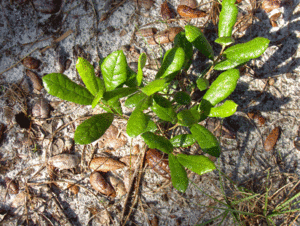Runner oak facts for kids
Quick facts for kids Runner oak |
|
|---|---|
 |
|
 |
|
| Conservation status | |
| Scientific classification | |
| Genus: |
Quercus
|
| Species: |
pumila
|
 |
|
| Natural range | |
| Synonyms | |
|
List
Quercus cinerea var. pumila (Walter) Curtis
Quercus phellos var. pumila (Walter) Michx. Cyclobalanopsis sericea (Aiton) Schottky Quercus cinerea var. nana A.DC. Quercus elliottii Wilbur Quercus phellos var. sericea Aiton Quercus pumila var. sericea (Aiton) Engelm. Quercus sericea (Aiton) Willd. |
|
The Quercus pumila, also known as the runner oak or running oak, is a type of small oak plant. It belongs to the beech family. You can find this plant growing naturally in the southeastern parts of the United States. This includes states like Mississippi, Alabama, Florida, Georgia, and the Carolinas.
About the Runner Oak
The runner oak is a deciduous shrub. This means it loses its leaves every year. It is usually quite small, often less than 1 meter (about 3 feet) tall.
What It Looks Like
The bark of the runner oak is gray or dark brown. Its leaves can grow up to 10 centimeters (about 4 inches) long. The leaves do not have any teeth or lobes (rounded sections). The top surface of the leaves is mostly smooth. However, the underside usually has a thick layer of reddish-brown hairs.
See also
 In Spanish: Quercus pumila para niños
In Spanish: Quercus pumila para niños


